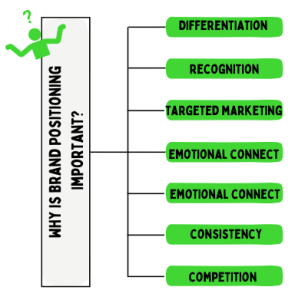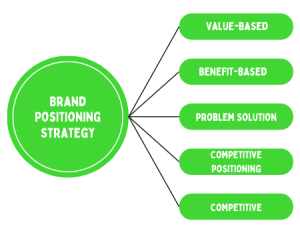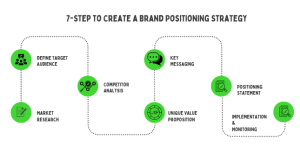How to Create a Brand Positioning Strategy for Your Business?
Apple’s brand positioning strategy revolves around delivering innovative, user-friendly technology that seamlessly integrates into everyday life. With a focus on elegant design and simplicity, Apple’s products and messaging resonate with creative individuals, tech enthusiasts, and those seeking a premium and intuitive user experience.

Their “Think Different” slogan embodies their spirit of challenging norms, fostering a sense of individuality, and positioning Apple as a leader in groundbreaking technology. The brand’s consistent and minimalist visual identity reinforces its premium status and innovation-driven approach.
If you are looking for impressive positioning in business and creating a strong image in the market, this is a must read blog for you.
What is Positioning in Marketing?

Positioning in marketing refers to the deliberate process of defining how a brand or product is perceived in the minds of consumers relative to its competitors. It involves crafting a distinct and memorable identity by highlighting unique attributes, benefits, and values that set the brand apart.
Positioning shapes consumers’ perceptions, influencing their purchasing decisions and emotional connections with the brand. Successful positioning aligns a brand with a specific target audience, creating a clear and compelling image that differentiates it within the competitive marketplace.
Brand character and positioning
Brand character refers to the personality, values, and traits that a brand embodies. It’s like giving your brand a human-like identity that resonates with your audience.
Just as individuals have distinct personalities, brands can have characteristics like being friendly, innovative, trustworthy, or adventurous. This character shapes how customers connect with the brand on an emotional level and influences their interactions with it.
Brand positioning, on the other hand, is the strategic approach a brand takes to differentiate itself in the market. It involves defining how you want your brand to be perceived in relation to competitors. It’s about identifying your unique value proposition (UVP), target audience, and the benefits your brand offers.
The brand character plays a significant role in brand positioning. For instance, if your brand character is fun-loving and youthful, your positioning strategy might target a younger audience and emphasise the enjoyment your products bring. If your brand character is trustworthy and reliable, your positioning could highlight the dependability of your services.
What Makes Brand Positioning Important?

Brand positioning is crucial for several reasons:
-
- Differentiation:
In a crowded marketplace, positioning helps your brand stand out by highlighting what makes it unique, giving consumers a reason to choose your brand over competitors. - Recognition:
Consistent positioning creates a distinct brand image that consumers recognize and remember, leading to increased brand recall and loyalty. - Targeted Marketing:
Clear positioning guides your marketing efforts, ensuring your messages resonate with the right audience and address their specific needs and desires. - Emotional Connection:
Effective positioning builds an emotional connection with consumers, allowing them to personally relate to your brand and its values. - Consistency:
Positioning provides a consistent framework for your brand’s identity, ensuring that your messaging, design, and overall communication remain cohesive across all channels. - Competitive Advantage:
A strong position gives you a competitive edge, helping you command premium pricing and establish your brand as a preferred choice. - Long-Term Success:
Successful positioning builds a strong brand reputation that can lead to lasting success, customer loyalty, and sustained growth.
- Differentiation:
Types of Brand Positioning Strategies
Some of the brand positioning strategies:

- Value-based positioning:
This strategy focuses on the brand’s value to its customers. The brand may position itself as the most affordable, highest quality, or innovative. For example, Dollar General is the “value leader” in the discount retail industry. - Benefit-based positioning:
This strategy focuses on the benefits the brand’s products or services offer customers. The brand may position itself as able to solve a problem, improve a customer’s life, or make life more convenient. For example, Crest toothpaste positions itself as able to “whiten teeth in just two weeks.” - Problem-solution positioning:
This strategy focuses on the problem the brand’s product or service solves. The brand may position itself as the only solution to a particular problem or as the best solution to one specific problem. For example, Head & Shoulders shampoo is the “solution to dandruff.” - Competitive positioning:
This strategy positions the brand concerning its competitors. The brand may position itself as being better than its competitors or as being the only alternative to its competitors. For example, Starbucks positions itself as the “premium coffee” brand, unlike its competitors like Dunkin’ Donuts and McDonald’s. - Image-based positioning:
This strategy positions the brand based on its image or personality. The brand may be stylish, luxurious, or environmentally friendly. For example, Apple is a “cool” and “innovative” brand.
7 Steps To Create Brand Positioning Strategy
Creating a brand positioning strategy involves a systematic approach. Here are seven steps to guide you through the process:

- Market Research:
Conduct thorough research to understand your industry, competitors, and target audience. Identify market trends, consumer preferences, and gaps your brand can fill. - Define Target Audience:
Clearly define your ideal customers based on demographics, behaviours, and psychographics. Understand their needs, pain points, and aspirations to tailor your positioning strategy. - Competitor Analysis:
Study competitors’ positioning strategies to identify gaps and opportunities. Differentiate your brand by highlighting aspects that your competitors don’t emphasise. - Unique Value Proposition (UVP):
Determine what sets your brand apart. Develop a strong UVP that encapsulates the fantastic benefits and solutions your brand offers to your target audience. - Key Messages:
Craft key messages that highlight your UVP and resonate with your target audience. These messages should communicate how your brand addresses customer needs and why it’s the best choice. - Positioning Statement:
Create a concise and impactful positioning statement that encapsulates your brand’s essence, target audience, UVP, and benefits. This statement should guide all branding efforts. - Implementation and Monitoring:
Apply your positioning strategy across all touchpoints – website, social media, marketing materials, customer service, etc. Continuously monitor the market, consumer feedback, and business performance to refine your strategy as needed.
Positioning statement example
Some of the positioning statement examples include:
- BMW: “The ultimate driving machine.”
- McDonald’s: “To be our customers’ favorite place and way to eat and drink.”
- Apple: “Think different.”
- Nike: “Just Do It.”
- Coca-Cola: “To refresh the world in mind, body, and spirit; to inspire moments of optimism and happiness.”
- Google: “To organise the world’s information and make it universally accessible and useful.”
- Disney: “To make people happy.”
- FedEx: “When it absolutely, positively has to be there overnight.”
- Volvo: “For life.”
- Starbucks: “To inspire and nurture the human spirit – one person, one cup, and one neighbourhood at a time.”
Also Read : How Much Does a Logo Design Cost in India
Conclusion
Creating a strong brand positioning strategy is like giving your brand a unique identity. You can make a lasting impact by understanding your audience, standing out from the crowd, and telling your brand’s story. So, remember, whether you’re just starting or looking to refresh your brand, a well-defined strategy is your compass. Need guidance? Contact us at hello[at]noboruworld.com – let’s shape your brand’s journey together!
FAQ
What is a brand positioning strategy?
A brand positioning strategy is the deliberate plan to define and communicate a brand’s unique value, benefits, and identity in a way that distinguishes it from competitors and resonates with the target audience.
Why is brand positioning important for my business?
Brand positioning is crucial as it shapes how customers perceive your brand. It helps create differentiation, build recognition, and establish a strong brand identity that influences purchasing decisions and builds customer loyalty.
How do I identify my brand’s unique value proposition (UVP)?
To determine your UVP, analyse what makes your brand distinct – whether it’s a unique feature, exceptional quality, or solving a specific customer problem. Focus on what sets you apart from competitors and resonates with your target audience.
Can brand positioning change over time?
Yes, brand positioning can evolve due to market shifts, changes in consumer preferences, or business strategies. It’s essential to regularly assess your brand’s positioning to ensure it remains relevant and aligns with your brand’s growth trajectory.
Also Read – Effective Amazon Positioning: A Complete Guide



